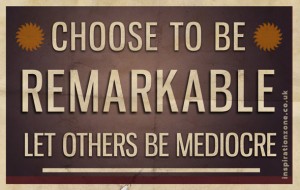 Brands have it tough these days. Many are trying to make the “social leap,” but are still stuck in the traditional marketing thought process of “controlling the message.” It can be a bit hard to switch gears, especially when Madison Avenue still feeds us the same old lines; however, Madison Avenue doesn’t get it either. The days of handing your marketing over to a bunch of agency wonks without getting involved and staying involved are quickly coming to an end—at least if you want real results. Companies must be hands-on now, and be willing to jump into the conversation and participate, because that’s what their customers demand. Social is where your audience lives. It’s how they want to communicate with each other and where they share brand experience—YOUR brand experience.
Brands have it tough these days. Many are trying to make the “social leap,” but are still stuck in the traditional marketing thought process of “controlling the message.” It can be a bit hard to switch gears, especially when Madison Avenue still feeds us the same old lines; however, Madison Avenue doesn’t get it either. The days of handing your marketing over to a bunch of agency wonks without getting involved and staying involved are quickly coming to an end—at least if you want real results. Companies must be hands-on now, and be willing to jump into the conversation and participate, because that’s what their customers demand. Social is where your audience lives. It’s how they want to communicate with each other and where they share brand experience—YOUR brand experience.
So what’s the fastest way to devolve from the old “agency” way of thinking to social communication? Empower those who work for you to create conversation and represent your brand—especially those who have a customer service or customer-facing role. If they build it, service it or sell it, they’re in a perfect position to communicate with your audience in a way that humanizes your brand, but only if you let them.
Many companies that are fearful of social media put muzzles on their employees in an effort to control the social conversation. However, if you’re going to have a social presence at all, just the opposite needs to happen.
In a Networking Exchange Blog post “Brands Under Pressure,” digital and social strategist Cheryl Burgess highlights Apple’s “Genius Bar,” which is the ultimate in employee branding for retail. She notes that the genius bar is “… a lynchpin of the most successful retail concepts and innovative employee brand relationships of our time. Apple simply gets it,” she writes…” employee branding matters.”
Check it out for yourself. Go into any Apple store and count the number of blue shirts milling about in the retail space. It’s astonishing—and each one is an Apple genius whose sole purpose is to communicate with customers, answer questions and share knowledge one-on-one. However, you don’t get a hard sell. The emphasis is on providing helpful information. In doing so, each employee puts a “face” on the Apple brand, and turns a shopping excursion into a human experience.
The great thing is, you don’t have to hire a zillion blue-shirts to stand around your company store to do the same thing for your brand. With a little guidance, your current employees can be blue-shirts for you in social circles.
The key word here is guidance! This includes having a written social media policy for your employees, going over it with them, and involving them in the process. Your employees can be your best advocates and a natural extension of your brand that gives you much better Return on Relationship™ than advertising ever could—but you need to switch your thinking by opening up your internal communications first.
Sit down and talk to your employees about how they can communicate your company mission and values. Open up a dialogue. Get their opinions. Involve them in the process of creating a social media policy so they feel empowered to spread the word about you within the right framework. But make sure that you do not overcomplicate the process and make them feel they are under a microscope.
Opening internal lines of communication and building healthy employer-employee relationships is the first step. The next is figuring out how to train them to communicate externally.
Cheryl’s blog post includes a handy infographic by Mindflash.com on How to Train Your Employees to Handle Social Media. It’s a visual primer on the basics, such as how to identify your employees’ social temperament, ideas on what to share and what not to share on personal as well as corporate social platforms, etc. If you’re just starting to wrap your mind around this concept, it’s a good place to start.
The short of all this is that in today’s digital age, you can’t afford to try to control your company’s brand. You need to learn to let go and become involved in the conversation already going on about you in the social space—and let your employees help you. Otherwise, the cost in market share is steep, because competitors that “get it” are already out there eating your lunch.
Now, I’m not saying you should let go of all the reins; there must be some structure and planning involved. However, a good social strategy MUST involve your employees. Give them some leeway. Educate them about your core values, and about what’s appropriate to share in social circles. Train them to be your brand evangelists and you’ll be amazed at the resulting Return on Relationship™!
Originally posted at TedRubin.com
 Social skills have suffered a great deal not necessarily due to “social media” per-say, but because of all the electronics we all carry and are addicted to in our daily lives. It did not used to be so easy to ignore people and seem disinterested because there was not much else to do during a meeting or when in a group. Now we have the world at our fingertips, so it is incredibly important to make it known to people what is acceptable and what is not. For instance when I am speaking to an audience, I do really want them quoting and posting about me via social channels as it spreads my words throughout the social graph, and to many who cannot attend. But when in a meeting or speaking one-to-one I certainly want their attention. But I also remember that many in the room are not really important to the meeting so I do not care if they are “off” somewhere else and I focus on those who “are” paying attention. We all need to set our standards and agenda’s and focus on those who are worthwhile and can deliver. You cannot truly impose ethics, but you can lead by example.
Social skills have suffered a great deal not necessarily due to “social media” per-say, but because of all the electronics we all carry and are addicted to in our daily lives. It did not used to be so easy to ignore people and seem disinterested because there was not much else to do during a meeting or when in a group. Now we have the world at our fingertips, so it is incredibly important to make it known to people what is acceptable and what is not. For instance when I am speaking to an audience, I do really want them quoting and posting about me via social channels as it spreads my words throughout the social graph, and to many who cannot attend. But when in a meeting or speaking one-to-one I certainly want their attention. But I also remember that many in the room are not really important to the meeting so I do not care if they are “off” somewhere else and I focus on those who “are” paying attention. We all need to set our standards and agenda’s and focus on those who are worthwhile and can deliver. You cannot truly impose ethics, but you can lead by example.







